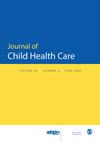Sarah A Holzman, Carol A Davis-Dao, Antoine E Khoury, Michelle A Fortier, Zeev N Kain
求助PDF
{"title":"Telemedicine and patient satisfaction during the COVID-19 pandemic: A case-control study of outpatient pediatric urology patients.","authors":"Sarah A Holzman, Carol A Davis-Dao, Antoine E Khoury, Michelle A Fortier, Zeev N Kain","doi":"10.1177/13674935211058272","DOIUrl":null,"url":null,"abstract":"<p><p>Telemedicine has increased during the coronavirus disease 2019 pandemic. Our objective was to determine if patient satisfaction with telemedicine differed from in-person visits in an academic pediatric urology clinic. Following outpatient telemedicine and in-person pediatric urology visits, the validated NRC Health© Patient Survey was used to assess patient experience. Patient satisfaction was assessed on a 10-point scale with scores of 9-10 considered \"satisfied\" and 1-8 considered \"not satisfied.\" Satisfaction scores between telemedicine and in-person groups were compared using McNemar's test, Wilcoxon signed rank test, and conditional logistic regression. Fifty-one patients had urology telemedicine visits during April-August 2020 and completed the NRC Health© Patient Survey. Propensity score matching was used to identify 102 in-person controls between January 2019 and March 2020. Ninety-two percent of telemedicine patients were satisfied compared to 87% of in-person patients (OR 1.7 95% CI [0.53-5.6]). Regression analysis adjusting for matching variables demonstrated that patient satisfaction was higher for telemedicine compared to in-person visits but was not statistically significant (OR 1.5 95% CI [0.43-5.6]). Patient satisfaction with telemedicine was similar to in-person visits in the pediatric urology clinic. Reduced waiting time and convenience associated with telemedicine visits provide an opportunity for telemedicine as a useful modality for pediatric urology.</p>","PeriodicalId":54388,"journal":{"name":"Journal of Child Health Care","volume":"27 3","pages":"351-359"},"PeriodicalIF":1.3000,"publicationDate":"2023-09-01","publicationTypes":"Journal Article","fieldsOfStudy":null,"isOpenAccess":false,"openAccessPdf":"","citationCount":"10","resultStr":null,"platform":"Semanticscholar","paperid":null,"PeriodicalName":"Journal of Child Health Care","FirstCategoryId":"3","ListUrlMain":"https://doi.org/10.1177/13674935211058272","RegionNum":4,"RegionCategory":"医学","ArticlePicture":[],"TitleCN":null,"AbstractTextCN":null,"PMCID":null,"EPubDate":"","PubModel":"","JCR":"Q3","JCRName":"NURSING","Score":null,"Total":0}
引用次数: 10
引用
批量引用
Abstract
Telemedicine has increased during the coronavirus disease 2019 pandemic. Our objective was to determine if patient satisfaction with telemedicine differed from in-person visits in an academic pediatric urology clinic. Following outpatient telemedicine and in-person pediatric urology visits, the validated NRC Health© Patient Survey was used to assess patient experience. Patient satisfaction was assessed on a 10-point scale with scores of 9-10 considered "satisfied" and 1-8 considered "not satisfied." Satisfaction scores between telemedicine and in-person groups were compared using McNemar's test, Wilcoxon signed rank test, and conditional logistic regression. Fifty-one patients had urology telemedicine visits during April-August 2020 and completed the NRC Health© Patient Survey. Propensity score matching was used to identify 102 in-person controls between January 2019 and March 2020. Ninety-two percent of telemedicine patients were satisfied compared to 87% of in-person patients (OR 1.7 95% CI [0.53-5.6]). Regression analysis adjusting for matching variables demonstrated that patient satisfaction was higher for telemedicine compared to in-person visits but was not statistically significant (OR 1.5 95% CI [0.43-5.6]). Patient satisfaction with telemedicine was similar to in-person visits in the pediatric urology clinic. Reduced waiting time and convenience associated with telemedicine visits provide an opportunity for telemedicine as a useful modality for pediatric urology.
COVID-19大流行期间远程医疗与患者满意度:儿科泌尿科门诊患者的病例对照研究
在2019年冠状病毒大流行期间,远程医疗有所增加。我们的目的是确定患者对远程医疗的满意度是否不同于在学术儿科泌尿科诊所的亲自就诊。在门诊远程医疗和儿科泌尿科就诊后,使用经过验证的NRC Health©患者调查来评估患者体验。患者满意度以10分制进行评估,9-10分为“满意”,1-8分为“不满意”。采用McNemar检验、Wilcoxon符号秩检验和条件logistic回归比较远程医疗组和现场组的满意度得分。在2020年4月至8月期间,51名患者进行了泌尿科远程医疗就诊,并完成了NRC Health©患者调查。倾向得分匹配用于识别2019年1月至2020年3月期间的102名亲自对照。92%的远程医疗患者满意,而87%的现场患者满意(OR为1.7,95% CI[0.53-5.6])。调整匹配变量的回归分析表明,远程医疗的患者满意度高于现场就诊,但没有统计学意义(OR 1.5 95% CI[0.43-5.6])。患者对远程医疗的满意度与儿科泌尿科门诊的现场就诊相似。与远程医疗就诊相关的等待时间减少和便利性为远程医疗作为儿科泌尿外科的一种有用模式提供了机会。
本文章由计算机程序翻译,如有差异,请以英文原文为准。

 求助内容:
求助内容: 应助结果提醒方式:
应助结果提醒方式:


